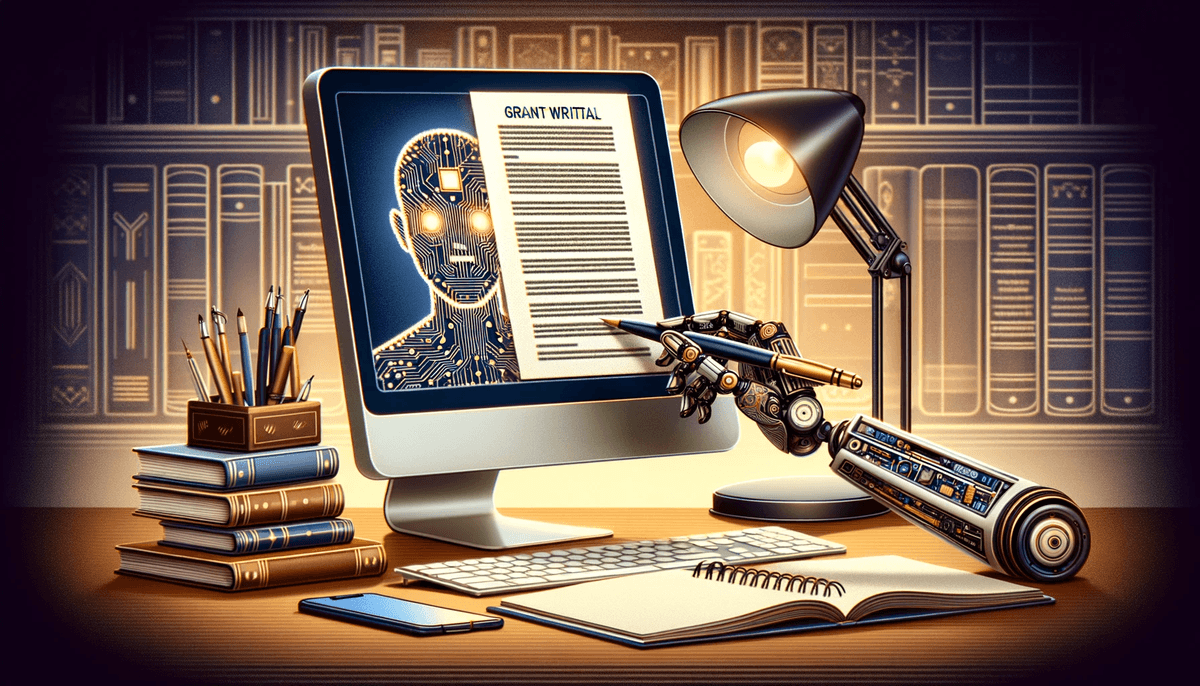The New Frontier in Fundraising: How AI Grant Writing is Revolutionizing Nonprofits

In the vast and dynamic terrain of nonprofit fundraising, one of the most critical – and challenging – endeavors has always been grant writing. This meticulous process of crafting proposals has traditionally demanded a significant allocation of resources: time, expertise, and often a touch of good fortune. However, the advent of Artificial Intelligence (AI) has ushered in a new era, fundamentally reshaping the way nonprofits approach grant writing. Here, we delve into the nuts and bolts of AI grant writing and explore its transformative impact on the sector.
Understanding AI Grant Writing
At its core, AI grant writing involves the use of machine learning algorithms and natural language processing (NLP) to assist in the preparation and tailoring of grant applications. These sophisticated AI systems are fed vast amounts of data, including successful grant proposals, guidelines provided by funders, and nuances in funding trends. By synthesizing this information, AI can generate insightful drafts, suggest impactful wording, and ensure proposals align closely with funders’ criteria.
The Efficiency Factor
One of the most immediate benefits AI brings to the table is efficiency. Grant writing is notoriously time-consuming. A single application can take upwards of 40-60 hours – a significant investment for organizations often running on lean operations. AI can reduce this investment by quickly sifting through data and providing a working draft as a starting point.
Moreover, AI-powered tools can handle multiple proposals simultaneously, tracking deadlines and streamlining processes that would otherwise be scattered across calendars and spreadsheets. This newfound efficiency not only saves time but frees up human resources, allowing staff to focus on other mission-critical tasks.
Enhanced Precision and Personalization
Every funder has a unique set of interests, priorities, and guidelines. Historically, customizing proposals to match each funder’s profile required a deep dive into research and careful crafting of narrative. AI streamlines this by analyzing previous successful applications and funders’ published materials to tailor proposals that hit the mark with precision.
AI tools can also integrate recent news, published papers, and emerging trends relevant to the nonprofit’s cause, demonstrating a current and robust understanding of the field. This level of personalization can make a significant difference in the eyes of grant reviewers.
The Competitive Edge
Nonprofits are continuously competing for limited funding sources. AI can provide a competitive edge by uncovering insights from past funding patterns, predicting areas of interest funders might be leaning towards, and even suggesting less tapped funding sources.
Additionally, grant writing AI can optimize language to resonate more effectively with its intended audience. By analyzing successful grant narratives, AI can determine words and phrases that are statistically linked to positive outcomes, enhancing the persuasive power of the proposal.
Real-time Collaboration and Learning
AI tools are not just static processors of information; they learn and adapt over time. As they process more data, these AI systems become more proficient in advising on grant strategy. Moreover, cloud-based AI platforms enable real-time collaboration among team members, regardless of their physical location. This collaborative environment, augmented by AI’s suggestions and insights, can enrich the grant writing process substantially.
Ethical and Practical Considerations
While AI in grant writing offers numerous advantages, it does necessitate careful consideration of ethical and practical issues. Firstly, the reliance on data raises questions about privacy and data security. It’s vital that AI systems managing sensitive information adhere to strict standards to avoid breaches.
Secondly, AI-generated texts should be closely monitored to ensure they uphold the integrity and values of the nonprofit sector. Humans should maintain control over the final narrative to confirm that proposals accurately reflect the mission and ethos of their organizations.
Training and Adaptability
Incorporating AI into grant writing practices does require upfront investment in training and adaptability. Staff members need to become adept at working with AI tools, understanding their capabilities, and interpreting their output. This transition phase must be managed with patience and strategic planning.
The Future of AI Grant Writing
The integration of AI into grant writing is more than a fleeting trend; it’s a strategic evolution that promises to redefine how nonprofits secure funding. As AI technology continues to improve and become more accessible, we can anticipate a marked shift in how grant strategy is conceived and executed.
AI and Human Synergy
Despite the considerable advantages of AI, the heart of grant writing remains distinctly human. Storytelling, emotional intelligence, and mission-driven passion are elements that AI cannot replicate. Therefore, the future lies in a harmonious blend of AI’s analytical power and human creativity and empathy. This synergy enables nonprofits to not only survive in a competitive funding landscape but to thrive.
Conclusion
AI grant writing is not about replacing human ingenuity; it’s about enhancing it with tools that unearth insights, suggest strategies, and save precious time. Embracing this technological shift can lead nonprofits to stronger proposals, more successful funding outcomes, and ultimately, a greater impact in their respective fields. As the sector continues to navigate the complexities of fundraising, AI stands as a potent ally ready to transform the once-daunting task of grant writing into a streamlined, impactful, and even inspiring endeavor.
In the narrative arc of nonprofit storytelling, AI is providing a fresh angle, one where data meets mission and technology serves humanity. As we stand on this new frontier, the collaboration between human vision and artificial intelligence is not just a possibility – it is already writing the future, one grant proposal at a time.

Daniel Errante
Lead Software Engineer, Typli.ai
Daniel is a software engineer, entrepreneur and AI enthusiast who has a passion for writing great software and coaching software development teams on how to build reliable, scalable and secure software. Over the past few years he has developed an interest in building artificial intelligence applications and is the head software engineer at Typli.ai.
Don't let complicated software hold you back. Step into effortless content creation with Typli and elevate your writing today. Experience AI content writing made simple.